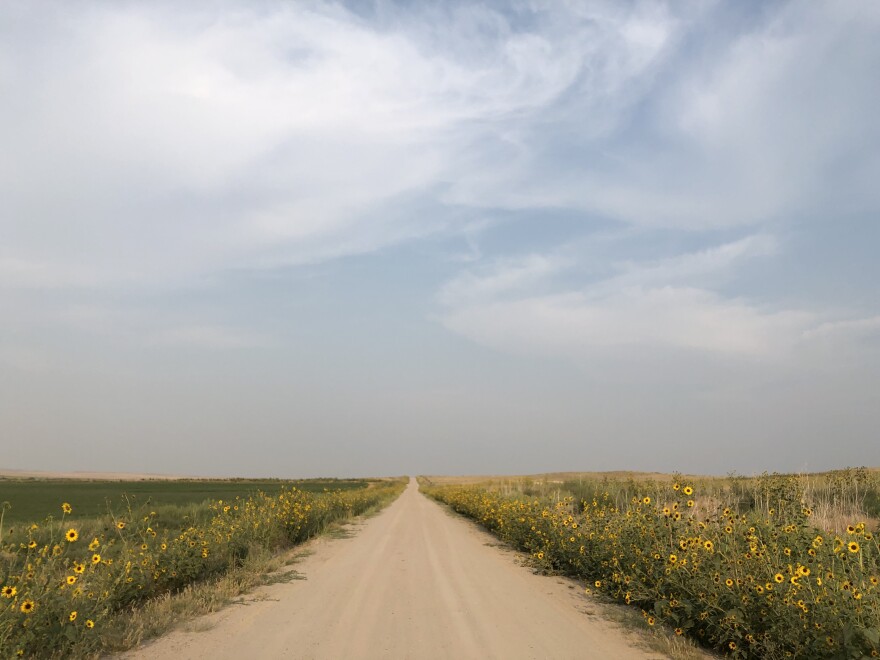When you think of pioneers, you might imagine Little House on the Prairie. Or the Oregon Trail game we all played in the nineties. One thing these popular depictions of pioneers have in common is they're White. But pioneers weren't all White, and historians argue it's important to set the record straight.
I was driving down a lonely country road. It was August, late in the day. Faraway wildfire smoke tinged everything hazy, making the sun seem closer to setting than it was. There were sunflowers everywhere. I was looking for a cemetery.
The cemetery is the last remnants of an old community that used to be here, northeast of Torrington, just shy of Nebraska. But I couldn't find it anywhere. Just these bucolic fields fecund with corn. I turned around.
And it was right there.
It was huddled at the edge of a cornfield, surrounded by a low fence. A big archway over the entrance read "Sheep Creek Cemetery."
I got out of the car and ignored the entrance, heading past the fence, nearly to the cornfield. Several yards away from the cemetery, out here, were more graves. These are the resting places of Black settlers, who weren't allowed to be buried inside the fence with the White settlers.
Those graves outside the fence are the last remnants of Empire, Wyoming.
Todd Guenther, anthropologist and historian at Central Wyoming College, told me Empire's story. "The town of Empire—or, let's start over right there, because it was never really a town. The community of Empire had its origins in 1908, when several families of Black immigrants from Nebraska moved up into the Sheep Creek Valley and claimed homesteads. They started farming and ranching in that area right on the Nebraska-Wyoming border."
These homesteaders were prosperous in Nebraska. They were descended from slaves, and their parents and grandparents had achieved an American dream: they'd gone from being owned to owning land. But now, in 1908, they were running out of farmland in Nebraska. And there was another thing.
Historian Jake Friefeld specializes in homesteaders. He said one of the families didn't feel very welcome in Nebraska.
"The Speese family were classically trained musicians," Friefeld said. "Children would travel and put on concerts. They show up to give a concert one night, and the mostly-White audience or all-White audience is upset that it's not a minstrel show."

So they set up farms over the border, in Wyoming. But farming was hard there. Dry, high altitude. And, Guenther said, hostile neighbors. "Right from the earliest days, there were racial tensions. Whenever something would disappear, or somebody would misplace an item or lose an item, the Black families would be accused right away of stealing."
There were threats of violence, of White mobs coming for Black people, for their families. And then, in 1913, something terrible happened.
Baseman Taylor was an Empire homesteader who sold his farm equipment and went to work in a Torrington restaurant. He suffered from mental illness.
"[Taylor's] family became concerned that he was a danger to himself, suffering from what was probably depression," Friefeld said. "They wanted him put in a hospital—I believe for that time it was called 'for the mentally insane.' They get the Goshen County Sheriff to come get him. He is beaten and then he dies in the custody—is killed by the Goshen county sheriff."
Baseman hadn't committed any crime or violence. This was a lynching.
Between 1904 and 1920, White Wyomingites lynched at least five Black men. That means that in those years, Wyoming had the number one lynching rate in the country.
"So I'm not talking about, like, the law and order lynchings in Laramie in the 1860s or '70s," Guenther clarified. "We're talking about racially motivated lynchings. Murder at the hands of a mob."
Soon after Baseman Taylor's murder, Empire dissolved. One or two at a time, people left. At its height, Empire was a collection of sixty-five Black-owned farms. By 1930, only four people were left--and the Dust Bowl quickly swept those four away.
For years, most people in Wyoming didn't know that Empire existed. And while I've been working on this story, most Wyomingites I've spoken to still don't. But a couple years ago the Wyoming State Museum sponsored a traveling exhibit about Empire. And there's a new Empire historical marker now, at a rest stop on I-25 near Wheatland. The marker was just erected this year.
Karla Slocum is a anthropologist who studies Black towns. She said stories of Black people's impact on American history have been erased.
"If we're going to tell the American story, and if we're going to tell American history, we need to have it complete," Slocum said. "And there are so many silences around the black presence. This Black town story is one of those parts that helps add to and round out the American story."
Back at the cemetery, I can just find two Empire graves-that is, graves outside the fence, where Black people were allowed to be buried. The two spread far apart, like the living were making room for generations to come. Like there would be other families, new families, crowding in between. But there's only these two graves, far apart from one another, in a cornfield.
This story is adapted from a forthcoming episode of The Modern West podcast as part of its series on ghost towns, both past and in the making. Subscribe wherever you get podcasts.







